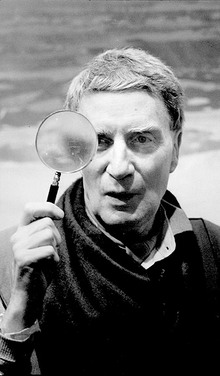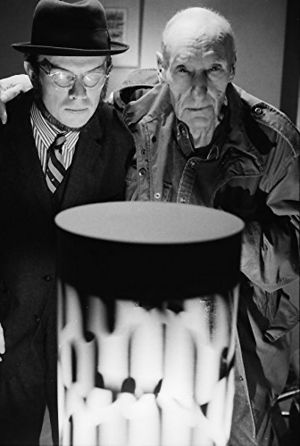Brion Gysin facts for kids
Quick facts for kids
Brion Gysin
|
|
|---|---|
 |
|
| Born | John Clifford Brian Gysin 19 January 1916 Taplow, England |
| Died | 13 July 1986 (aged 70) Paris, France |
| Occupation |
|
| Nationality | British/Canadian |
| Education | Sorbonne, Downside School |
| Literary movement | Beat, Postmodern, Asemic writing |
Brion Gysin (born John Clifford Brian Gysin; 19 January 1916 – 13 July 1986) was a British-Canadian artist. He was a painter, writer, sound poet, and inventor. He also created many experimental art devices.
Gysin is famous for using the cut-up technique. He developed this method with his close friend, the writer William S. Burroughs. The cut-up technique involves cutting up written text and rearranging it to create new meanings. Gysin also invented the Dreamachine with engineer Ian Sommerville. This device uses flickering lights to create patterns and colors that people see with their eyes closed. Even with his many inventions, Gysin spent most of his time on painting and drawing. His art was inspired by calligraphic styles, especially Japanese "grass" script and Arabic script. William S. Burroughs once said that Gysin was "the only man I ever respected."
Contents
Brion Gysin's Life Story
Early Years and School
John Clifford Brian Gysin was born in a Canadian military hospital in Taplow, England. His mother, Stella Margaret Martin, was from Canada. His father, Leonard Gysin, was a captain in the Canadian army. Sadly, his father died in battle eight months after Brion was born.
After his father's death, his mother returned to Canada. They settled in Edmonton, Alberta. Brion went to an Anglican boarding school there, where he was the only Catholic day student. He finished school at age fifteen. Then, he went to Downside School in England. This was a well-known Catholic school. Even though he attended a Catholic school, Gysin later developed his own beliefs and did not follow a specific religion.
Art in Paris
In 1934, Gysin moved to Paris, France. He studied at the Sorbonne. There, he met many artists and writers. He joined a group called the Surrealists. This group included famous artists like Salvador Dalí and Picasso.
A year later, Gysin had his first art show in Paris. Many famous artists were also part of this show. But on the day of the show, the leader of the Surrealist group, André Breton, asked Gysin to leave the group. Gysin was only 19 years old. This event affected him deeply. He later felt that this early rejection caused other problems in his art career.
After World War II
After serving in the U.S. army during World War II, Gysin wrote a book. It was a biography about Josiah Henson, titled To Master, a Long Goodnight: The History of Slavery in Canada (1946). Gysin was also a very talented artist. He spent 18 months learning the Japanese language, including its beautiful calligraphy. This greatly influenced his artwork.
In 1949, he received a Fulbright Fellowship. He planned to study the history of slavery in Spain, but he later changed his mind. He moved to Tangier, Morocco, after visiting the city with writer Paul Bowles in 1950. He remained friends with travel writer Anne Cumming until his death.
Morocco and the Beat Hotel
In 1954, Gysin opened a restaurant in Tangier called The 1001 Nights. He ran it with his friend Mohamed Hamri, who was the cook. Gysin hired the Master Musicians of Jajouka to perform there. They played music for people from all over the world, including William S. Burroughs. Gysin lost the restaurant in 1958, and it closed down.
That same year, Gysin moved back to Paris. He stayed in a building at 9 rue Gît-le-Cœur, which became known as the Beat Hotel. While working on a drawing, he accidentally discovered a new art technique.
In September 1959, Gysin shared his discovery with William S. Burroughs. This led to the development of the cut-up technique. Gysin helped Burroughs edit some of his novels. They also worked together on a large book called The Third Mind. Burroughs later told The Guardian newspaper that Gysin was "the only man that I've ever respected in my life." In 1969, Gysin finished his own important novel, The Process.
Gysin changed the cut-up technique to create what he called "permutation poems." In these poems, a phrase was repeated, but the words were rearranged each time. For example, "I don't dig work, man" could become "Man, work I don't dig." Many of these poems were made using an early computer program. In 1960, the BBC asked Gysin to create sounds for broadcast. He made "Pistol Poem" by recording gunshots from different distances and then cutting and splicing the sounds together.
With Ian Sommerville, Gysin built the Dreamachine in 1961. This device was called "the first art object to be seen with the eyes closed." It uses flickering lights to create a change in how people see and feel, by affecting their brain waves.

Later Years and Achievements
In April 1974, Gysin began to experience health problems. He was later diagnosed with colon cancer. He underwent several surgeries.
In 1985, Gysin was honored by France. He was made an American Commander of the French Ordre des Arts et des Lettres, which is a special award for artists. He also started working with the famous jazz musician Steve Lacy. In 1986, they recorded an album called Self-Portrait Jumping. On this album, Gysin sang and rapped his own texts. Other musicians like Don Cherry also performed on the album.
Death
Brion Gysin passed away on 13 July 1986, from lung cancer. His friend Anne Cumming arranged his funeral. His ashes were scattered at the Caves of Hercules in Morocco. An obituary in The New York Times described him as a person who had so many great ideas that most artists would use them for a whole career. Later that year, his novel, The Last Museum, was published after his death.
Influence on Other Artists
Brion Gysin's ideas inspired many artists. According to José Férez Kuri, who wrote a book about Gysin, his "radical ideas" influenced artists of the Beat Generation. They also inspired later artists like David Bowie, Mick Jagger, Keith Haring, and Laurie Anderson. Other artists who were influenced by Gysin include Genesis P-Orridge, John Zorn, and Brian Jones.
See also
 In Spanish: Brion Gysin para niños
In Spanish: Brion Gysin para niños
- Asemic writing
- Brian Jones Presents The Pipes Of Pan at Jajouka
Images for kids







